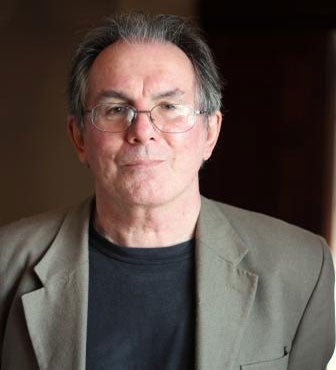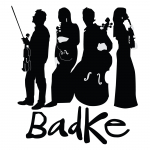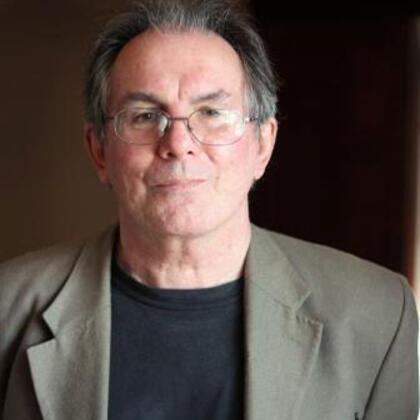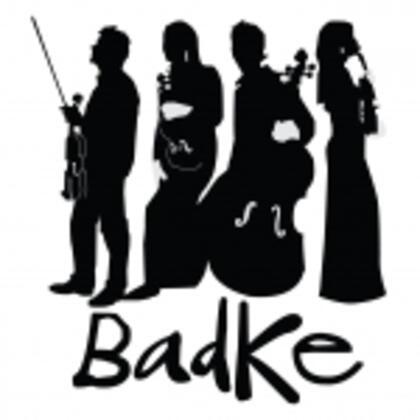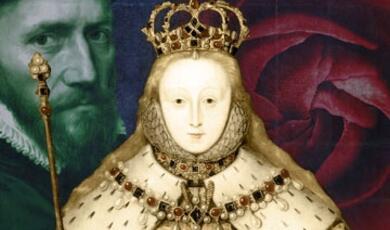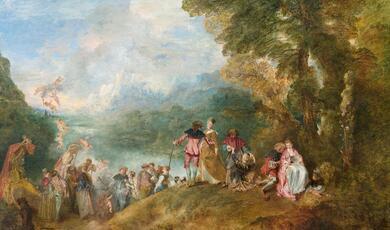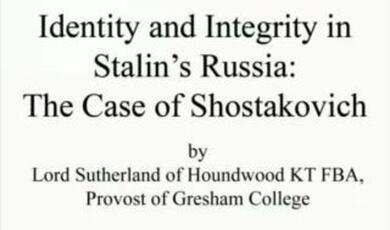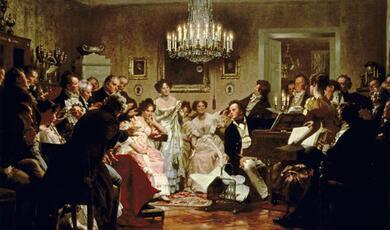Joseph Haydn, Op 76 No 1 in G major
Share
- Details
- Transcript
- Audio
- Downloads
- Extra Reading
Haydn's Op. 76, the last set of six quartets he composed, are generally recognised as the pinnacle of his writing in the genre. They were completed in 1796-7 and published a couple of years later. No. 1 in G major, as befits the opening quartet of the set, is grandiose and symphonic in breadth and construction, with some impressive "orchestral" writing for the quartet, and with a broad tonal canvas including frequent explorations of the parallel minor mode.
Download Transcript
Haydn: Quartet Op. 76, No. 1
Professor Roger Parker
28/01/2010
My six Gresham lectures this year repeat a format I adopted two years ago. Each lecture is dedicated to a string quartet: the first half features me, offering an introduction to the work; and the second half features the Badke Quartet, who will play it in its entirety. In the series two years ago, the Badke and I ranged freely around the quartet repertoire, presenting a broad selection of what the genre had to offer, from Haydn at one end to Bartok at the other. This time we're limiting our repertory to a brief period of about thirty years in Vienna at the end of the eighteenth and the start of the nineteenth centuries, and restricting ourselves to the work of three composers. But to describe this in terms of "limiting" and "restricting" gives entirely the wrong impression, one of meagre resources: on the contrary, the three composers in question being Haydn, Mozart and Beethoven, the choices before us were formidable in the extreme. Between them, these three puissant gentlemen wrote many more than a hundred string quartets; taken together their corpus forms the core repertory not only of this particular ensemble, but of the entire genre of chamber music. We were, in other words, confronted by a tremendous embarrassment of riches; I can only hope that our final choice (three quartets from Haydn's Op. 76, then two by Mozart, and finally Beethoven's Op. 95) gives at least a partial indication of what was produced in these remarkable years in Vienna.
I explained something about the rise of the string quartet as a medium during my first lecture in that previous series (a lecture that centred on Mozart's so-called "Dissonance" quartet). And I'm pleased to report that, thanks to the ever-splendid Gresham College website, you're no more than a mouse's click or two away from access to that lecture in an array of formats; so I won't repeat myself unduly here. It is, though, worth reiterating that the string quartet, whose origins were as a severely cut-down version of early eighteenth-century orchestral groupings, intended for performances in smaller, often domestic venues, soon took on a life of its own. By the later eighteenth century, this particular ensemble of string instruments, on the surface a rather strange and unbalanced one with its two violins, one viola and one cello, became one of the most common and certainly the most celebrated chamber-music grouping: first in Austria and other German-speaking lands, and then spreading, with the spread of its repertoire, to other areas of Europe.
The string quartet's gathering prestige, as the most elevated chamber ensemble for complex musical thought, was largely caused by the contributions of the composers you'll hear about and then hear in these lectures: first Haydn, who practically invented the combination in its 'serious music' form; then Mozart, consciously emulating Haydn's model; and finally Beethoven in emulation of both, and through his continuing dedication to the genre setting the seal on its pre-eminence. Because of these three composers, the string quartet became a major repository for a certain kind of elite music; its repertory seems to sum up a particular attitude to our musical past. To put this another way, the 'rise' of the string quartet more-or-less coincided with the rise of quasi-religious fervour for a certain kind of Austro-German instrumental music; its prestige became a significant contributor to the idea, which emerged during the nineteenth century and is still to some extent with us, that that particular tradition was central to our musical universe-was, to be brief, the type of music against which all others should be measured. This is why so many composers of the nineteenth and twentieth centuries-by no means all of them Austro-German, some of them from quite unlikely musical backgrounds-chose to write string quartets, and did so during times in which other, larger, more varied combinations might have seemed far better suited to the taste of the day. These aspiring string quartet composers wanted to measure themselves against the past excellence founded by Haydn, Mozart and Beethoven. To put it a little more cynically, they wanted to secure a ticket that, one day, might give them entrance to the pantheon of great composers: that house in the sky which offers the world, on permanent exhibition, a constantly-sounding, ever-renewing imaginary museum of musical works.
As I said a moment ago, Haydn was the first of this great trio, and is indeed sometimes called, not without reason, "the father of the string quartet". He was born in 1732 in lower Austria, gained his musical education as a choirboy in Vienna, and following that earned a precarious musical living in the capital. It was there, during the late 1750s and already well into his twenties, that he wrote his first string quartets. Among the first in this new genre, they were resolutely in the modern, newly simple "galant" style (very little of that intricate counterpoint of the previous generation), and-in part to reflect this-they were called "divertimenti" rather than anything more grand. Haydn's critical career move, though, came in 1761, when he entered the service of the Esterházy family, one of the noblest and richest in the Austro-Hungarian empire. He remained there for nearly thirty years, soon becoming the court's Kapellmeister, which may sound quite grand but was in some respects still a menial position, that of a jobbing composer and impresario. During the late 1760s and early 1770s he produced eighteen further quartets; all of them were now in four movements rather than five, and they were gathered into opus numbers for publication as Opp. 9, 17 and 20. What's crucial, though, is that Haydn imbued these works with a new seriousness of approach, devoting to the ensemble a new aesthetic weight, one rarely found in instrumental music up to that point. His experiment proved, as we know, hugely influential. These eighteen string quartets were the first to retain a firm place in the repertory; the foundations of the imaginary museum had been set.
The six quartets of the Op. 76 set, the first of which we're going to hear today, come many quartets later, in the mid 1790s, near the end of Haydn's fascinating creative tussle with the medium. By that stage he had left the comparative seclusion of the Esterházy household, and had enjoyed enormous international success, particularly as a symphonist, during visits to both Paris and London. He was now again living in Vienna and, having long been a shadowy figure in the Austro-Hungarian capital, he was now, because of his London fame, a considerable celebrity: the irony of this situation, of the prophet finally finding fame in his own country, was apparently one that he was not shy of pointing out. Because of his newfound fame, a great deal of Haydn's compositional energy in these last years went not on instrumental music (whose prestige was only then developing in Vienna) but on a magnificent series of grand choral works, both religious and secular. However, he found time for, indeed dedicated considerable energy and invention to, this Op. 76 set of quartets, a circumstance perhaps indicative of the dedication he had nurtured for the ensemble and its possibilities. Their exceptional quality was recognized immediately. When the great English musicologist Charles Burney came across them in 1799, he pronounced that he had "never received more pleasure from instrumental music: they are full of invention, fire, good taste, and new effects, and seem the production, not of a sublime genius who has written so much and so well already, but of one of highly-cultivated talents, who had expended none of his fire before".
Quartets in the 1790s were very different compositions from those Haydn had written in the 1760s and 1770s. Most importantly, and although we know that they were still played in domestic situations, they now also functioned as concert pieces, and for that reason were composed on a scale and with a degree of grand gesture that suited public consumption. The first quartet in the series, the one you're about to hear, presents this new, 'public' manner at the very start of its opening movement. It's marked 'Allegro con spirito' and we can understand it, if you will, as the composer laying out his stall, setting the tone of what is to come. For this reason, and for many others, it's worth lingering over for a moment or two.
The very first bars of Op. 76, No. 1 are-you have to be sleeping soundly to possibly miss it-an obvious call to attention, something hardly needed in the domestic situations in which earlier quartets were played, but very useful in the eighteenth-century concert hall. We hear three loud, wide-spaced chords: full of expansively gestural double stops in the upper three strings, and boldly, unambiguously asserting the main key by means of a simple cadence. In one sense, you might understand these three chords as an instrumental rendering of those three loud knocks with which theatres in the seventeenth and eighteenth centuries marked the beginning of the evening's entertainment; in another, related way, you might imagine them as Haydn, at the very start of his new quartet series, announcing to the crowd: "Here; I; am!". In this case, though, the call to order is also there for another reason: it prepares for the fact that quartet proper begins in a highly unusual way, one that might otherwise have been lost on those famously noisy and inattentive eighteenth-century listeners.
So what comes after the three chords? The continuation might seem, in 1791, the unlikeliest start of all for a first movement: we start with the solo cello, announcing what seems for all the world to be an old-fashioned fugue subject, a relic of a past age. However, and as we might expect from Haydn (remember what Burney said, "full of invention, fire, good taste, and new effects"), this is no more than a pretend fugue-one of those wry, ambiguous gestures to past musical styles which Haydn was so fond of throughout his life. The cello's fugue 'subject', four bars long, is imitated by four bars for the viola, as we might expect in a polite fugue; but when the viola comes in, the cello unexpectedly stops. Then comes a repetition of this exchange, but for duos rather that soloists: four bars for the second violin and cello, another four for first violin and viola. And then, finally, we hear the four instruments together, in the conventional quartet texture. What Haydn has done in this strange opening is to announce, with his usual wit and grace, that these quartets will be celebrations of the unexpected; and, what's more, celebrations in which all the four instruments will share, each of them with its own line, its own part to play.
There's one other passage in this first movement that I want to call your attention to, and it comes for the first time not long after the passage I've been talking about. The 'normal' quartet texture has been plugging away, and the movement is now behaving itself by modulating to a related key. But at a certain point it becomes unstuck. The first violin gets an arpeggio figure, usual enough, but suddenly this figure gets taken up by all the instruments together in an emphatic unison, and at the same time the tonality dives into strange regions, tinged by the minor mode. The arpeggios finally come to rest on a dissonant chord, which is repeated insistently by all the instruments together; and then the clouds clear and the first half of the movement come to a sunny close with a new and self-consciously simple melody on the first violin. I've lingered on this moment of disruption, which you'll hear repeated in the second half of the movement, because it's another kind of significant 'new effect', this time a harmonic and textural one, and because, as we'll hear, its effect ripples out into the other movements of the quartet, thus expanding the musical range and reach of the work as a whole.
I'll need to be briefer with the other three movements. The second, an Adagio sostenuto, starts with what we might hear as a reminder: that Haydn's later years were mostly taken up with vocal music of one kind or another. This opening, in a resonant C major, plainly gestures towards the singing voice: it's probably best described as a hymn for instruments: simple, intense, direct; strongly anticipating late Beethoven. The hymn then alternates with two other distinctive and contrasting textures. In the first is a poignant duet between the cello and the first violin: again reminiscent of vocal music, even a love duet of a kind. This texture then shades into something different: the cello joins the accompanying inner instruments and the first violin takes off on its own, becoming syncopated from the rest and registrally separated, flying into its highest reaches. Is its separation painful or ethereal? As with so many other of Haydn's later slow movements, the emotions are delicately poised between sorrow and consolation. The hymn's reassuring serenity is perhaps restored at the very end of the movement, but the cello's still-restless arpeggios continue underneath, posing questions, reminding us that... well, reminding me at least of some lines from one Philip Larkin's saddest poems (there are many to choose from) about the condition of being, as was Haydn in 1796, a 'senior citizen'. Here's what Larkin wrote:
Only the young can be alone freely.
The time is shorter now for company,
And sitting by a lamp more often brings
Not peace, but other things.
A dash of the third movement will put a stop to such gloomy ruminations. It's in the form of a minuet and trio, but is much nearer in spirit to the more modern, one-in-a-bar, 'scherzo'. The minuet is, indeed, almost manically driven, with a relentless emphasis on the opening, three note figure, interrupted only a sudden explosions of 'full orchestra' sound that are patently there to shock the listener. Listen out, too for periodic dives into parallel minor, echoing those harmonic expansions of the first movement. The trio is, in this context, as extreme a contrast as can be imagined: it reverts to the 'popular' vein heard fleetingly in the first movement: a bouncing Ländler-type dance, dominated by the first violin.
The last movement, marked 'Allegro ma non troppo', harbours yet more surprises. While the other movements have all gestured briefly to the minor mode, this one, in which we would usually expect tension to wind down, begins frankly in the minor, and with that emphatic unison texture that had so brusquely interrupted the progress of the first movement. And for most of the finale Haydn keeps the tension at this pitch, in the middle leading the four instruments on an extremely adventurous harmonic excursion, a dense thicket of chromatic change. But then, true to the last to the mercurial spirit of this wonderful quartet, Haydn ends with yet another abrupt shift of mood. The murky harmonic regions are suddenly banished, to be replaced by a disarmingly simple, major-mode melody, spiced with some remarkable virtuosity from the first violin. As if to bring us full circle, those three 'orchestral' chords from the start of the first movement, suitable altered in melodic shape, bring the work to a triumphant close.
It's time for me to introduce the Badke Quartet, who are of course going to make sense of this music-much better and more complete sense than my words could ever do. But before they come on I want to reiterate a point mentioned in the last series, but I think bearing repetition. In spite of Haydn's gestures to a 'public' audience-gestures that are, at least in my opinion, a critical feature of this set of quartets-it's still true that string quartets such as this one are not ideally consumed in large concert halls, places in which strangers congregate. As you'll immediately see and hear, the levels of communication between the members of a good quartet are as subtle and intimate as any in music; but some of this sense of intense conversation needs ideally to spread to the audience. And so, in this sense, our moments of communication on this side of the performance (and we'll also try to make time for some questions at the end) may be useful in more ways than one. What I hope, at least, is that in some small way the fact that these performances are surrounded by discussion, will encourage and aid this sense of communication. It's as well to recall that we live in an uniquely disciplined musical world, one in which audience noise, even audience appreciation, are rigorously policed. (If you doubt this, just try clapping at the end of the slow movement-perfectly normal in eighteenth-century performances-and register the withering glances that come your way.) This discipline has evident advantages, not least in the levels of concentration we can bring to complex music such as Haydn's quartet. But there are also losses, quite serious ones, not least in diminishing that sense of exchange that should ideally emerge between performers and listeners. If these lunchtime lecture recitals, with their words and then music, can encourage greater communication between the musicians on stage and those listening in the auditorium, then they will have fulfilled a function that just words, or just music, will always struggle to achieve,
And so, with that last, I hope not-too-pious homily, let me introduce the Badke Quartet, which formed in 2002 and is now widely recognised as one of Britain's finest young chamber ensembles. Recipients of the Leverhulme Junior Chamber Music Fellowship at the Royal Academy of Music from 2005 to 2009, the Quartet regularly performs at festivals in the UK and abroad, including the Aldeburgh and Verbier Festivals, the Belfast Festival at Queen's and the London String Quartet Week. They've played in some of the UK's most prestigious chamber music venues, including the Wigmore Hall, St George's Bristol, St David's Hall, Cardiff, The Bridgewater Hall, St John's Smith Square and the Royal Festival Hall. In 2007, the Badke were awarded First Prize and Audience Prize at the Fifth Melbourne International Chamber Music Competition, which is probably the most prestigious international competition of its kind. In 2009 they made their Musikverein début in Vienna, performed with Mark Padmore in France and returned to Ireland for a Music Network Tour. In the same year the Quartet were also seen twice at the Wigmore Hall and at London's newest chamber music venue, Kings Place. In other words, we're very lucky to have them. Please join me in welcoming them onstage: Heather Badke, first violin; Emma Parker, second violin; Jon Thorne, viola; and Jonathan Byers, cello.
©Professor Roger Parker, Gresham College 2010
Part of:
This event was on Thu, 28 Jan 2010
Support Gresham
Gresham College has offered an outstanding education to the public free of charge for over 400 years. Today, Gresham plays an important role in fostering a love of learning and a greater understanding of ourselves and the world around us. Your donation will help to widen our reach and to broaden our audience, allowing more people to benefit from a high-quality education from some of the brightest minds.


 Login
Login
